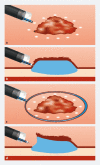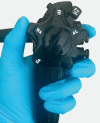Endoscopic submucosal dissection: How to be more efficient?
- PMID: 34790536
- PMCID: PMC8589544
- DOI: 10.1055/a-1554-3884
Endoscopic submucosal dissection: How to be more efficient?
Abstract
Endoscopic submucosal dissection (ESD) allows an "en bloc" resection with safety margins (R0 resection) regardless of the size of the lesion. However, while R0 brings a real benefit for the patient, it is not considered sufficient by many experts to justify the technical difficulties and the longer procedure time compared to piecemeal mucosectomy. The aims of this review are to provide several technical and strategical tips to help you save time and become comfortable during ESD procedures. ESD is divided into several intertwined phases: injection, incision, access to the submucosae, and submucosal dissection itself. During injection there are some mistakes that should not be made: a superficial injection, or on the contrary, a too deep injection. A good needle and good injection technique are mandatory. Some techniques, such as repeated injection or prolonged lifting solution, can help maintain the lift. After this step, mucosal incision can be made, taking care to have a good margin to allow an R0 resection. Starting the mucosal incision from a small point allows calibration of the depth of the incision and then obtaining a nice incision. Trimming is also very important to widen submucosal access. Then comes the submucosal dissection itself. Strategies such as the tunnel strategy or the pocket creation method can help to facilitate dissection, but more importantly, traction systems have become unavoidable, especially in the stomach and colon. Most common complications are bleeding and perforation, and they usually can be managed endoscopically.
The Author(s). This is an open access article published by Thieme under the terms of the Creative Commons Attribution-NonDerivative-NonCommercial License, permitting copying and reproduction so long as the original work is given appropriate credit. Contents may not be used for commercial purposes, or adapted, remixed, transformed or built upon. (https://creativecommons.org/licenses/by-nc-nd/4.0/).
Conflict of interest statement
Competing interests Drs. Pioche, Jacques, Legros, and Rivory are consultants for Olympus, Norgine, Fuji, and Erbe.
Figures











References
-
- Fuccio L, Repici A, Hassan C et al.Why attempt en bloc resection of non-pedunculated colorectal adenomas? A systematic review of the prevalence of superficial submucosal invasive cancer after endoscopic submucosal dissection. Gut. 2018;67:1464–1474. - PubMed
Publication types
LinkOut - more resources
Full Text Sources
Medical
Research Materials
Miscellaneous

